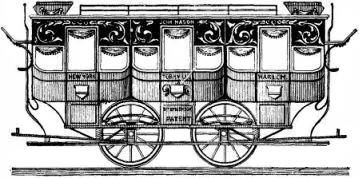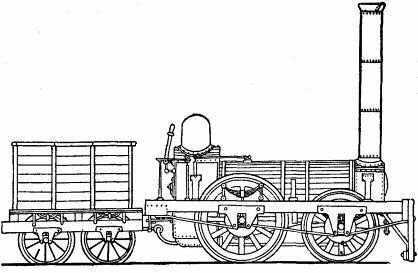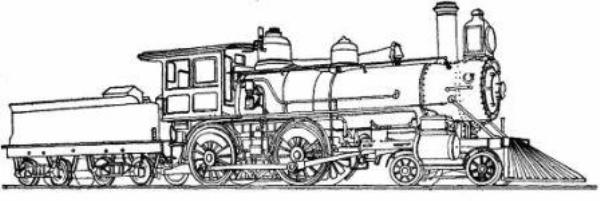|

The "John Mason" Horse Car and the Rail-Road |
History of Railroads in the 1800s: The Horse Carriage
Trains began as horse-drawn carts or wagons that carried
heavy loads.
The problem was that
even the gravel roads were invariably rough in places.
It then occurred to some bright spark that it would be
better to lay down flat, wooden rails and then to place
a rim on the wagon wheels that would keep the wagons on
the rails - the idea of the
Horse Car and the rail-road
was born.
Rails reduced friction and increased efficiency.
History of Railroads in the 1800s: The Rail-Road
The first rail-road of this kind in America was built at
Boston in 1807. It was a very basic design used to carry
soil from the top of a hill to Boston harbor. However
the wooden rails soon wore out, and another bright spark
had the idea to nail strips of iron on top of the wooden
rail-roads. The idea caught on and long lines of
railroads of this kind were soon built to carry both
passengers and produce.
History of Railroads in the 1800s for kids: The First Railroads
The first railroads - literally rail-roads - were built by
privately, by companies, towns and states. Any one having horses and
wagons with flanged (rimmed) wheels could use the railway on the
payment of a small sum of money. The
Horse car, and the first railroads they
ran on, were developed about the same time as the steam locomotive was
invented in the late 1820s.
|

An Early Locomotive |
History of Railroads in the 1800s: The Locomotive
The
steamboat had been invented, steam was used to drive boats through
the water. Inventors had been looking for ways to use steam to haul
wagons and carriages over a railroad and the steam locomotive was
invented by George Stephenson.
Railroads in the 1800s: The Early Locomotives
The early railroad trains were extremely basic. The cars
were little more than stagecoaches with flanged wheels.
The cars were secured together with chains, and when the
engine started or stopped, there was a terrible
clanging, bumping and jolting. The smoke pipe of the
engine was very tall and was hinged so that it could be
let down when coming to a low bridge or a tunnel. The
chimney of a locomotive was called a smoke-stack. The
first passenger carriages were extremely uncomfortable,
cinders and smoke flew straight into the passengers'
faces. But the trains over the railroads went faster
than steamboats and quickly became the favored
form of transportation. The first steam locomotives were
built with fixed wheels, which worked well on straight
tracks but not so well in America's mountainous
landscape.
Railroads in the 1800s for kids: Timeline of the Trains, Inventors
and Innovators
The timeline of the famous men, innovators and inventors
who developed the railroads and the steam locomotives:
● 1814:
George Stephenson constructed a locomotive that could pull 30
tons up a hill at 4 mph. Stephenson called his locomotive, the
Blutcher. He is considered to be the inventor of the first steam
locomotive engine for railways.
● 1825: Colonel John Stevens
is considered to be the father of American railroads and
designed and built a steam locomotive capable of hauling several
passenger cars in Hoboken, New Jersey
● 1828: The
first operational locomotive on an American railroad was the
Stourbridge Lion. The Lion was built in 1828 and imported from
England by Horatio Allen of New York
● 1829:
George Stephenson He named
his steam locomotive the 'Rocket'
● 1830: In 1830, the Tom Thumb was the first American-built
steam locomotive to be operated on a common-carrier
railroad. The Tom Thumb was designed and built by
Peter Cooper
● 1831: The
name of the first locomotive to pull a train of cars over an
American railroad was the 1831 Best Friend of Charleston. The
Best Friend was designed by E. L. Miller (it operated for 6
months until its boiler exploded)
● 1831: In
1831 Matthias Baldwin established the Baldwin Locomotive Works
and established the prototype from which later engines developed
● 1832: In
1832 John Jervis, designed the locomotive called the
'Experiment' which had a swiveling four-wheeled guide truck
that could follow the track and enabled locomotives to travel on
railways with tighter curves - more suited to mountainous
terrain
● 1833:
The firm of Robert Stephenson in England constructed the
locomotive the "John Bull" for the Camden and Amboy Railroad.
The John Bull was one of the first American locomotives to be
fitted with a pilot aka the 'cow catcher'. The 'cow-catcher' was
the nickname given to the inclined frame in front of a
locomotive that pushed obstructions from the track. The pilot
aka the 'cow catcher' soon became standard devices on all
American locomotives
● 1837: The
invention of the
Morse Code
and the first telegraph
line led to telegraph lines being erected alongside
the Railroads
|

Steam Locomotive 1800s |
The
Railroads in the 1800s for kids -
Expansion
Between 1849 and 1858 21,000 miles of railroad were built in the
United States of America. Just two years later, in 1860, there were
more than 30,000 miles of railroad in actual operation and one
continuous line of rails ran from
New York City
to the Mississippi
River. Traveling on the early railroads of the 1800's was
uncomfortable, the railroad cars were roughly made and they jolted
badly. One train ran only a comparatively short distance. Then the
railroad traveler had to alight, get something to drink and eat, and
baggage was transferred to another train. But despite all
discomforts of the railroads of the 1800s, traveling in the worst of
railroad cars was still much better than traveling in the old
stagecoaches.
The
Railroads in the 1800s for kids -
The 4-4-0 locomotive, the
"American" type
The design of the locomotives changed considerably.
Locomotives could be constructed in a number of ways. They were
classified by the wheel arrangements of the leading truck, driving
wheels, and the trailing truck. The 4-4-0 configuration, which
became known as the 'American' type had four wheels on the leading
truck and four driving wheels, with no trailing truck. The Central
Pacific's locomotive, called the Jupiter, and the Union Pacific's
Engine No. 119, were both 4-4-0 locomotives - the "American
Standard".
The
Railroads in the 1800s for kids -
The Transcontinental Railroad
An historic event in the history
of the railroads in the 1800s occurred on May 10, 1869.
On this date the Union Pacific and the Central Pacific railroad
companies joined their individual sets of tracks to make the first
Transcontinental Railroad in the United States. The two railroads
linked the East and West coast of North America. The railroad was
3000 miles long and enabled people to travel from New York to
California in a few days days, rather than weeks and months.
Importance and
Significance of
the Railroads in the 1800s
The development of railroads was one of the most important events of
the U.S. Industrial Revolution. The importance and significance of the Railroads in the 1800s was:
● Railroads
cut travel time by 90%
● Railroads
improved transportation across the U.S.
● Thousands
of settlers utilized the Railroads in the 1800s to move west
● New cities
and towns emerged along the route of the railways. For
additional facts refer to the
History of
Urbanization in America
● Many industrialist acquired great wealth, the unscrupulous
businessmen were referred to as
Robber Barons
● It
increased trade by providing the means for transporting
agricultural products and manufactured goods across the country
and to the eastern seaboard for export to Europe
● The
construction of the railroads was a feat of U.S. engineering and a source of great national
pride to the United States
● The "Underground
Railroad" escape route for slaves was also established in
1831 and used railroad terminology for its secret codes
●
The Civil War heralded the use of
railroads as a Important means of transporting troops and supplies and the wounded
in hospital trains. - refer to
Civil War Inventions and Technology.
Railroads in the
1800s for kids
The info about the Railroads in the
1800s provides important information about this Important event that occured during the presidency of the 6th President of the United States of America.
Read on for interesting facts about the Railroads in the 1800s.
Facts about the Railroads in the 1800s for kids
Interesting Facts about the Railroads in the 1800s History are
detailed below. The history is told in a series of
facts providing a simple method of relating to the expansion of the Railroads in the 1800s. The facts answer the questions of when the
expansion of the Railroads in the 1800s, its effects on
transportation and its significance
to the United States of America.
Facts about the
Railroads in
the 1800s for kids
Railroads in the
1800s Fact 1:
In 1830, the rail
network consisted of just 30 miles
Railroads in the
1800s Fact 2:
By 1840, about 60
different railroads operated 2800 miles (4500 km) of
track in the 26 states.
Railroads in the
1800s Fact 3:
Between 1849 and 1858
21,000 miles of railroad were built in the United States
Railroads in the
1800s Fact 4:
By 1860 there were
more than 30,000 miles of railroad in actual operation
Railroads in the
1800s Fact 5:
The US rail network
grew from 35,000 miles to a peak of 254,000 miles in
1916.
Railroads in the
1800s Fact 6:
Early railroad tracks
were constructed of wood. Iron rails were developed that
would strengthen the tracks and could carry the weight
of large, steam-powered locomotives
Railroads in the
1800s Fact 7:
The Erie Railroad and
the Albany & New York Central connected New York State
and New York City with the Great Lakes
Railroads in the
1800s Fact 8:
The earliest survey
map in the U.S. that shows a commercial "tramroad" was
drawn in Pennsylvania in October 1809 by John Thomson
Railroads in the
1800s Fact 9:
The Tracks were built
in a variety of gauges (the distance between the rails)
that ranged from 2 and one-half feet to 6 feet.
Railroads in the
1800s Fact 10:
In 1833 Andrew
Jackson traveled from Baltimore to Ellicott's Mills,
becoming the first U.S. president to ride on the
railroad
Railroads in the
1800s Fact 11:
Speculators in the
1850s bought land hoping that a railroad would come
through an area and they could then resell the land at a
much higher price.
Railroads in the
1800s Fact 12:
The first caboose was placed in service in 1841 on the
Auburn & Syracuse Railroad in New York. A caboose was a
car attached to the rear of a freight train fitted up
for the accommodation of the conductor, brakeman, and
chance passengers
Railroads in the
1800s Fact 13:
The
American Civil War (1861-1865) became
the first Important conflict in which railroads played a
Important role as both sides used trains to move troops and
supplies
Railroads in the
1800s Fact 14:
Thousands of
unskilled laborers built the railroads over
difficult terrain, with the aid of wheelbarrows, hand
tools, horses, and mules. Refer to
Transcontinental Railroad
Railroads in the
1800s Fact 15:
In 1887 Railroads
became the first U.S. Important industry to be subject to
economic regulation when Congress passed the Interstate
Commerce Act
Railroads in the
1800s Fact 16:
At noon on November
18, 1883 standard time was introduced to the nation by
the railroads
Railroads in the
1800s Fact 17:
The first Pullman
Sleeping Car went into service in 1859
Railroads in the
1800s Fact 18:
Railroads were faster
and cheaper than canals to construct, and they did not
freeze over in the winter so became the favored form of
transportation
Railroads in the
1800s Fact 19:
In the 1870s and
1880s strikes broke out against railroads and the
Pullman Palace Car Company. Pinkerton guards were hired
by the companies to break up the strikes - refer to
the
Great Railroad Strike of 1877
Railroads in the
1800s Fact
20: The railroads were
shut down during the great railroad strike of 1894 and
the true importance of the railroads was fully realized.
The
1916
Adamson Act and the ruling of the Supreme Court
established and 8 hour working day for railroad workers
Facts about the
Railroads in
the 1800s for kids
Railroads in the 1800s - President John Quincy Adams Video
The article on the
Railroads in the 1800s provides an overview of one of the Important
innovations of his presidential term in office.
For additional info refer to
Facts on Industrial Revolution Inventions.
The following
John Quincy Adams video will
give you additional important facts and dates about the political events experienced by the 6th American President whose presidency spanned from March 4, 1825 to March 4, 1829.
Railroads in the 1800s
●
Facts about the Railroads in the 1800s for kids and schools
●
Facts about the construction of the railroads
● Facts about trains
and Railroads in the 1800s
●
John Quincy Adams Presidency from March 4, 1825 to March 4, 1829
●
Fast, fun, interesting facts about the Railroads in the
1800s
●
Foreign & Domestic
policies of President John Quincy Adams
●
John Quincy Adams Presidency and
the significance of the Railroads in the 1800s for schools,
homework, kids and children
|